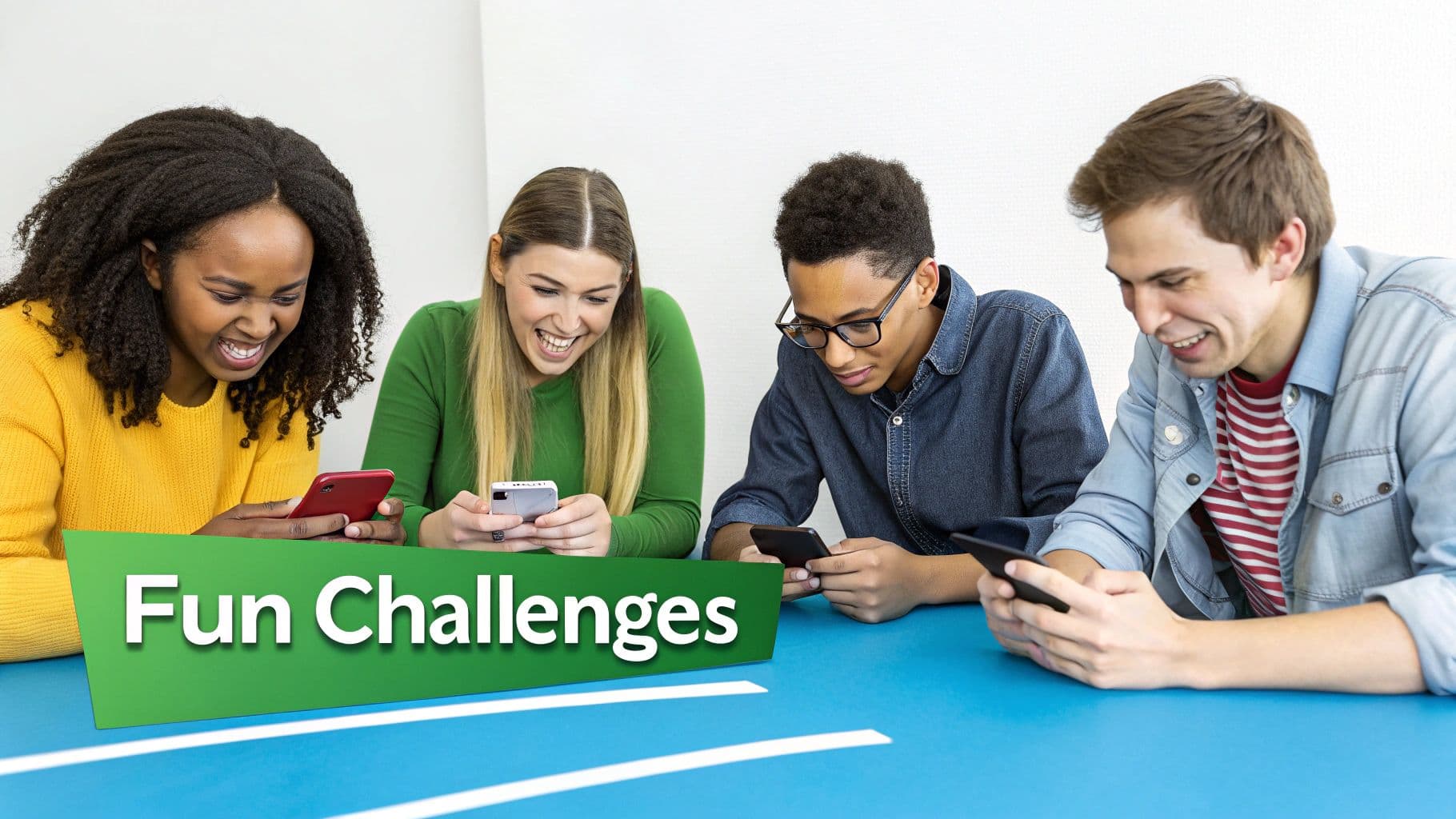The Rise of Social Gaming: A Digital Revolution
The Impact of Technology on Social Games
Better mobile devices and faster internet have made social gaming more engaging and accessible. Players can now enjoy stunning graphics, real-time multiplayer matches, and seamless social features from their phones. The rise of cloud gaming means you no longer need expensive hardware to play high-quality games with friends - a major shift bringing more people into gaming communities.
The numbers tell an impressive story about social gaming's growth. The market hit $41.4 billion in 2023 and experts predict it will reach $110.9 billion by 2030, growing at 15.1% per year. This growth comes from improved technology and more people seeking social connections through games. Read more market details here.
Shifting Consumer Behaviors and Social Interaction
More players now look for games that let them connect and compete with others. Social features make games fun and keep players spending more time with their gaming friends. The social aspect has become just as important as the gameplay itself.
The Future of Social Gaming
Big gaming companies put social features at the heart of new and existing games. They recognize that players want more ways to interact and build communities. New gaming platforms are creating spaces that exceed just playing games - they're social hubs where people gather, chat, and share experiences. This focus on community and connection is shaping how we'll play and socialize in games for years to come.
Mobile Gaming: A New Era of Social Entertainment

Mobile games have grown beyond simple time-killers into rich platforms where people connect, compete, and build friendships. These games create shared experiences that bring people together across distances in unprecedented ways.
Finding the Sweet Spot: Easy to Learn, Fun to Master
The best social mobile games strike an important balance: They're simple enough for anyone to start playing immediately and offer enough strategic depth to keep experienced players engaged. Take Words With Friends, for example. This game uses basic word-building mechanics while rewarding clever play and strategic thinking through competitive leaderboards.
Growing Through Friend Connections
Most popular mobile social games use friend invitation systems to expand naturally. Players earn rewards for bringing in friends who then invite their networks. This creates an ongoing cycle of organic growth that builds active player communities through real social connections rather than paid advertising.
Building Real Community
The best mobile social games focus on meaningful player interactions. They include features like team play, chat systems, and group challenges that help players form genuine connections. Game designers carefully craft these social elements to encourage positive interactions that make players feel like part of a welcoming community.
Mobile Gaming's Massive Growth
The numbers show just how big mobile social gaming has become. In 2023, Roblox topped the charts with 217 million downloads, followed closely by Subway Surfers at 214 million and Ludo King at 164 million. Popular titles like Candy Crush Saga and 8 Ball Pool also saw huge download numbers, proving mobile gaming's broad appeal. For more stats, check out this detailed report on mobile gaming trends. The data makes it clear: mobile platforms are now essential for reaching today's gaming audience.
Building Thriving Gaming Communities
Social connections have become a core part of successful games today. Understanding how to build and maintain an active player community is critical for any game's long-term success. This section explores proven strategies for community building, moderation, and player engagement.
Fostering Meaningful Relationships in Games
The best social games help players form real connections with each other. When players work together toward shared goals or engage in friendly competition, they develop lasting bonds. Features like guilds and teamplay give players a sense of belonging and shared purpose. These social ties keep players coming back and strengthen the whole community. You might be interested in: How to master organic Instagram growth with Gainsty.
Effective Community Management: Moderation and More
A healthy gaming community needs clear rules and consistent moderation. Good moderators create a welcoming space where all players feel safe and respected. Community managers should actively engage with players by organizing events and building rapport. This hands-on approach helps develop trust between players and game administrators. Social platforms like Facebook have expanded gaming's reach dramatically, connecting players across the globe. Popular MMOs benefit from this broader social integration, as players share experiences beyond the game. Learn more about gaming communities here.
Designing for Positive Interactions
Game design directly impacts how players interact with each other. Key social features include:
In-game chat systems
Player-to-player gifting
Team-based gameplay
Social rewards and recognition
These elements need careful implementation to encourage positive behavior and prevent toxicity.
Real-World Examples of Thriving Communities
Games like Fortnite and Animal Crossing show the power of strong communities. These titles have grown beyond simple games into thriving social spaces where millions of players connect daily. Their success demonstrates how crucial community building is for any game's long-term growth and player retention.
Mastering Monetization in Social Media Games

Creating a profitable social media game requires finding the sweet spot between making money and keeping players happy. Gone are the days of basic freemium models - successful games now weave monetization naturally into their social features.
Designing Compelling Premium Features
The key is understanding what players value enough to pay for. Players often invest in items that help them stand out or progress faster, like unique character customization options or special abilities. But these premium features need to add real value without making free players feel left out.
Virtual Economies and In-Game Purchases
A strong virtual economy forms the backbone of successful monetization. Just like a real marketplace, you need the right mix of items that players want to buy and trade. When certain items are rare, players become more willing to spend money to get them. This trading activity also helps build community connections. Learn more about growing your game business with Gainsty's comprehensive guide.
Balancing Revenue and Player Satisfaction
The most successful games put player enjoyment first. Pushing too hard for purchases drives players away. Smart developers constantly analyze player behavior and adjust their approach based on data. Simple A/B tests of different prices and premium features help find what works best for revenue and player retention.
Case Studies in Successful Monetization
Popular games like Candy Crush Saga and Clash of Clans show how to do monetization right. They let everyone enjoy the core game for free while offering tempting premium options that make the experience even better. Players never feel forced to spend but often choose to because the paid features genuinely improve their gameplay. This balanced strategy has helped these games stay profitable for years.
The Next Frontier of Social Gaming
Social media games are evolving rapidly with new technologies opening up exciting opportunities for players to connect. Key technologies like augmented reality (AR), virtual reality (VR), blockchain, and artificial intelligence (AI) are creating fresh ways for people to play and interact together. Let's explore how these advances are shaping social gaming's future.
Augmented Reality: Bridging the Gap Between Real and Virtual
AR brings digital elements into our physical world in fun new ways. Picture playing a social game where you hunt for virtual creatures in your neighborhood park with friends, or customize your actual home with virtual decorations you've earned. This mix of real and digital creates engaging local gameplay that gets people moving and socializing both online and in person.
Virtual Reality: Immersive Social Experiences
VR creates fully digital spaces where players can connect more deeply. Friends can meet up in virtual game worlds, enjoy concerts together, or work on creative projects as a team. The technology turns social games into shared spaces focused on bringing people together in meaningful ways.
Blockchain: Ownership and Decentralization
Blockchain gives players true ownership of their digital items in social games. You can collect unique in-game assets, trade them freely in open marketplaces, and even earn crypto while playing. This creates thriving game economies where players have more control. Blockchain also enables community-driven decisions about game updates and direction.
Artificial Intelligence: Personalized and Dynamic Gameplay
AI helps create custom experiences in social games based on how each person likes to play. The technology generates fresh content and scenarios to keep things exciting over time. For example, AI can adjust opponent difficulty to match your skill level, making matches fair and fun. Check out our guide on growing your organic Instagram following. This personal touch keeps players engaged with both the game and social features.
The Future is Social: Connecting in New Ways
These technologies work together to create amazing possibilities. Think about a VR social game using blockchain where players craft and trade unique items together using AI-powered creative tools. The potential for new ways to connect is incredible. As the technology improves, we'll see even more creative and immersive social gaming experiences emerge.
"Essential Strategies For Social Game Development":
Essential Strategies for Social Game Development

Creating a successful social game takes more than just fun gameplay - it needs smart planning and community building from day one. The social element is what makes these games special, so focusing on player interaction is key.
Core Features That Drive Engagement
When designing your social game, start with the features that get players talking and competing. Some must-have elements include:
Real-time multiplayer modes where players can interact live
Competition features like rankings and tournaments
Social tools such as team play and chat systems
These core mechanics help form lasting player connections that keep them coming back.
Smart Testing for Better Launches
A solid testing process makes all the difference. Be sure to include:
Multiple testing rounds to gather player input and fix issues
Split testing different features to see what players prefer
This helps catch problems early and ensures players have a smooth experience at launch.
Keeping Players Active Long-Term
Long-term success requires constant attention to the player experience. Some proven approaches:
Fresh content updates that give players new things to do
Special events that create excitement and bring players back
Player feedback that shapes future game updates
Players stick around when they feel heard and see the game growing.
Learning From Past Games
Take time to study both hits and misses in social gaming. Understanding why certain features worked or failed helps create better games. Use these insights to build something that truly connects with players.
With careful planning and focus on what players want, you can create social games that bring people together and keep them engaged. For help growing your game's community on platforms like Instagram, check out Gainsty for authentic engagement tools.















